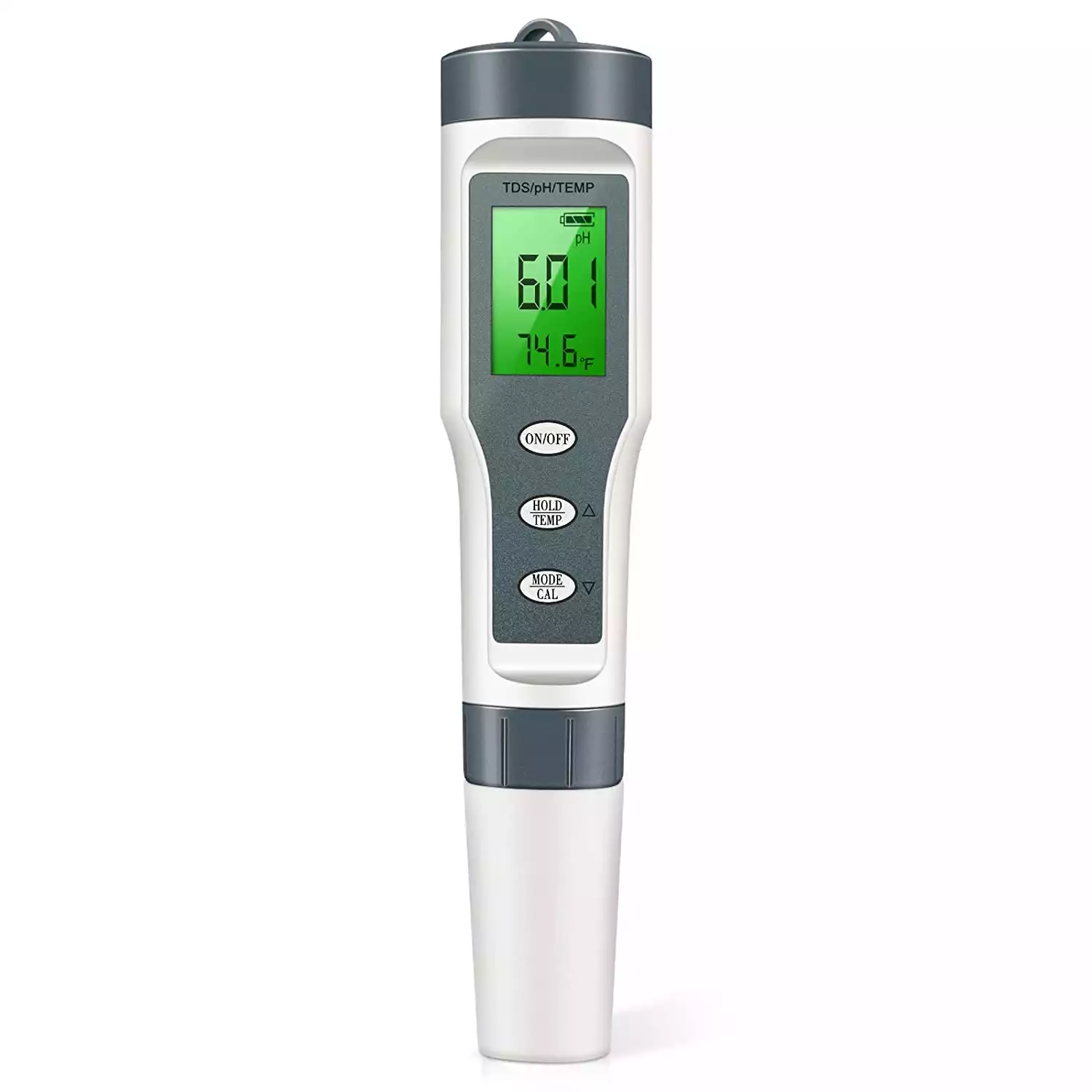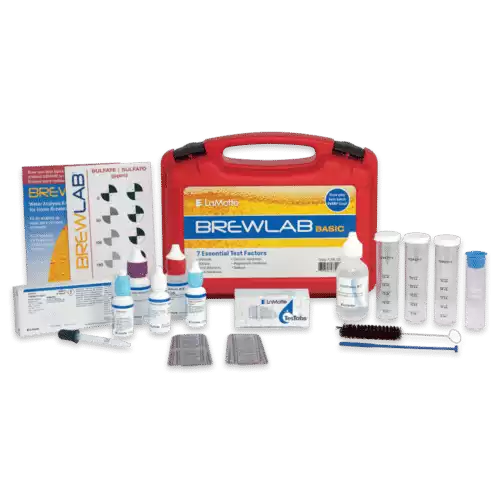With its light, wine-like flavor profile, Kolsch beers benefit from a tailored water profile. An ideal water profile for Kolsch beer will highlight its strong points while also providing crisp clarity.
The best water profile for Kolsch beer starts with distilled or reverse osmosis water. The water profile should be soft and highlight the dry crispness of the style. The end result should have a 5.2-5.3 pH, 70-80 mg/L sulfate, 35-40 mg/L chloride, 37 mg/L calcium, 10 mg/L magnesium, 25 mg/L sodium, and 80 mg/L bicarbonate.
Keep reading to find out more about the importance of water chemistry for this German beer, and how to achieve this water profile for your homebrew.
Topics We Cover
What is the ideal water profile for a Kolsch?
No matter the water you start with, there is an ideal water profile you should aim for when brewing a Kolsch. With the proper water profile, you will have a great foundation for your beer to build upon.
The water profile for a Kolsch beer should be soft since its light malts are not as acidic as dark malts. Your pH should be between 5.2 and 5.3 which will require lactic acid or acidulated malts. A Kolsch benefits from a 2:1 sulfate to chloride ratio and should have 37 mg/L calcium, 10 mg/L magnesium, 25 mg/L sodium, and 80 mg/L bicarbonate.
You should avoid highly alkaline water as the pH will be too high for yeast to ferment properly. Most of the minerals are present to either support the yeast or highlight the flavor profile of this style.
Should you use a certain city’s water profile for a Kolsch?
We all love a good tradition, whether that’s playing the fiddle on the roof or using a certain city’s water profile. Using the water profile of Cologne (or Köln) when brewing Kolsch is a fairly common practice. It sounds reasonable to use the water profile of the city a beer came from.
While city water profiles are a great way to start considering water chemistry, you do not need to use a certain city’s water profile for most beers. In the case of a Kolsch, its home city Cologne has a good water profile you can follow.
However, you are often much better off tailoring a water profile to the beer style you are aiming for. Historic water profiles can lend themselves to a certain style. That said, they often have unnecessary elements.
What is the ideal pH?
Higher pH levels can increase the production of undesirable off-flavors such as diacetyl and fusel alcohols. These flavors are not part of the Kolsch style and should be avoided.
The ideal mash pH for a Kolsch beer is in the 5.2-5.3 range.
In order to lower your mash pH to this range, you will need to use either lactic acid or acidulated malt. The former can add a hint of sour tang that is present in several German beers.
Use this waterproof 3-in-1 pH meter to check the acidity of your brewing water. Automatic temperature control corrects hot water samples during brew day!
What’s the ideal mineral content?
The other side of the coin of water profiles is the mineral content. This can affect plenty of aspects including the pH and flavors.
To brew a great Kolsch beer, aim for this mineral content:
- 37 mg/L calcium – Calcium supports yeast growth through nutrients and enzyme reactions.
- 10 mg/L magnesium – Like calcium, magnesium will support yeast growth through nutrients and enzyme reactions.
- 25 mg/L sodium – Sodium will accentuate the sweetness along with chloride.
- 70-80 mg/L sulfate – With this beer, you will want a 2:1 sulfate to chloride ratio. This ratio will lend itself to the dry crispness of a Kolsch.
- 35-40 mg/L chloride – Along with the sodium, chloride will accentuate the sweetness of the brew. When paired with the correct ratio of sulfate, it will also lend contribute to the crispness of the Kolsch.
- 80 mg/L bicarbonate – Bicarbonate provides some alkalinity.
How do you find your water profile?
The first step for diving into the world of water chemistry is deciding what to start with. Your tap water will have a profile that may or may not be suitable for brewing. Sometimes it is easier to start with a blank slate instead of adjusting an existing profile.
Once you know your water profile you can decide whether it is best to start with reverse osmosis (RO), distilled, or tap water.
There are three common ways to find your water profile. In order of accuracy and quality, the options are:
- A professional water testing lab
- A home testing kit
- Your city’s water report
Brewing with your tap water without knowing its profile can be fine in most cases, but you will not benefit from a tailored water profile.
This kit was formulated specifically for testing beer used for brewing beer, includes everything you need, and will last for years!
How important is the water profile in brewing?
All beers—from the macro-brewed “water” beers to the heaviest stout—are composed mostly of water. With this in mind, it makes sense that water can have a large impact on your homebrew beer.
A customized water profile can bring out the best in your beer. The mineral composition, pH, and other elements will highlight or mute various flavors in your beer. In addition to flavor, water profiles can affect yeast health, mouthfeel, and aroma.
The different minerals in your water can enhance certain flavors. For example, sodium and chlorides can increase the perceived sweetness. On the other hand, sulfates can highlight hop characteristics.
Other minerals in your water will have other benefits. Minerals such as magnesium, calcium, and zinc can improve yeast health.
How do you adjust your brew water profile?
The two main ways to adjust your brew water profile are adding brewing salts or diluting with pure water. The latter is best when your water has too much of the majority of minerals. The former is better when you need to be more specific.
Dilution works fine as a blunt tool, but for any fine-tuning, you will want to use brewing salts. When adding minerals it is important to know that many of them will have several effects. Some common brewing salts include:
- Epsom Salt (MgSO4) will slightly lower pH and will raise Mg and SO4 levels.
- Chalk (CaCO3) will raise pH.
- Baking Soda (NaHCO3) will slightly raise pH.
- Calcium Chloride (CaCl2) will lower pH and raise chloride levels.
- Gypsum (CaSO4) will lower pH.
When adding brewing salts, use a gram scale for precise adjustments. A water profile calculator such as Bru’n Water can also be helpful.
What is the best water to start with for a Kolsch?
You have a couple of options when it comes to starting water. You can start with RO or distilled water so that you don’t have to adjust an existing profile. On the other hand, you can start with your local tap water which will have a specific profile.
The best water to start with when brewing Kolsch is RO or distilled water. Unless your tap water is relatively close to the ideal water profile without adjustments, it is easier to start with a blank slate.
Since the ideal water profile for Kolsch is relatively simple you won’t need a lot of brewing salts to create it. If you have a robust home filtration system you may be alright adjusting your filtered water.
What to add to RO or distilled water to make a Kolsch
If you prefer to start with RO or distilled water you’re able to start from a blank slate. The size of your batch will influence how much of each brewer’s salt you’ll need. Let’s use a 5-gallon batch for this example.
To make a 5-gallon Kolsch you will need to add:
- 2.4 grams Chalk (CaCO3)
- 0.98 grams Gypsum (CaSO4)
- 2 grams Epsom Salt (MgSO4)
- 1.14 grams Salt (NaCl)
What makes a good Kolsch?
Water chemistry is so easily overlooked because there are other factors that contribute to a great beer. Kolsch is no different.
A good Kolsch is characterized by its unique brewing process, yeast, and hops. Most have an SRM between 3 and 6, IBU between 18 and 28, and an ABV between 4.8 and 5.3%.
Brewing process
Kolsch beers are unique in the beer world in that they are considered hybrid beers. Despite fermenting at ale temperatures and with ale yeast, they are also lagered.
The clarity and crispness that this beer is known for come, in part, from the lagering process it goes through.
Yeast
Another particular aspect of this beer style is the yeast used.
Two strains of ale yeast that come from traditional breweries in Cologne are highly recommended when making Kolsch. These two are:
- WLP029
- Wyeast 2565
Both of these strains are known for fermenting clean and crisp. They work very well for this hybrid beer.
Hops
Kolsch is not a hops-centric beer, but it does strike a nice balance between malts and hops. Part of that balance comes from selecting the right hops. Most Kolsch beers use German noble hops exclusively.
Common Kolsch hops include:
- Hallertuaer
- Tettnang
- Perle
- Spalt
Spalt and Perle are typically used for their aroma while Hallertuaer and Tettnang are used for bitterness.



